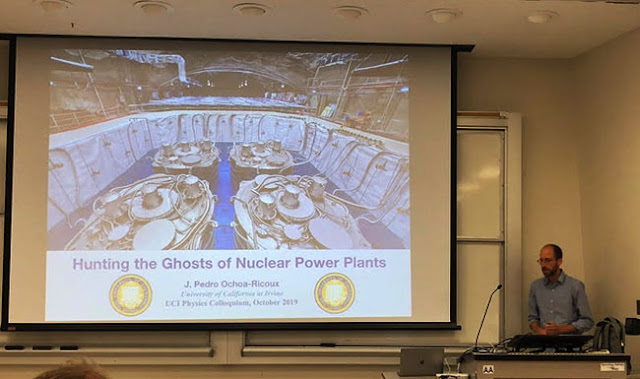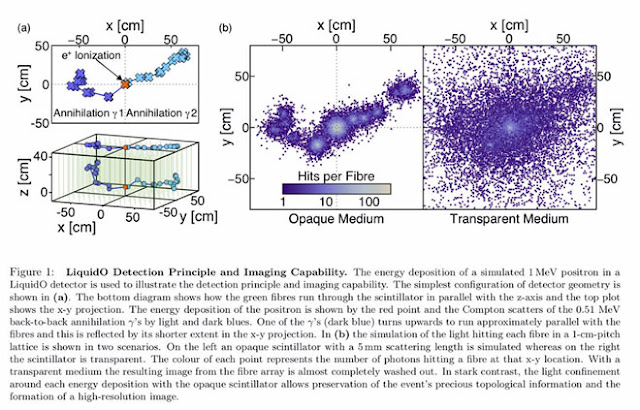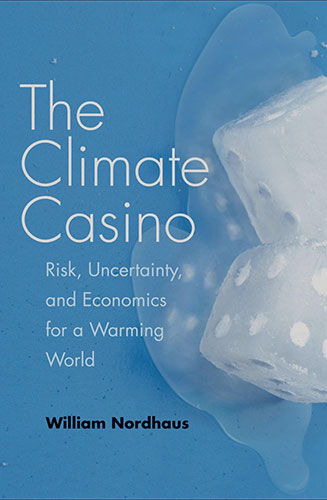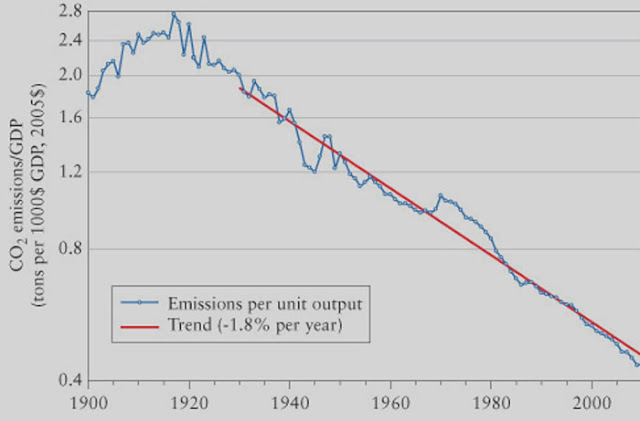Well this week the scope remained packed up, but at least we spotted Saturn, Jupiter and the Moon close together and recorded the view with the iPhone.
This photo was taken at the Hyatt Regency Jazz (under the stars) Series and you can also see a little blue fuzz of lens glare of some sort. I noticed that the blue fuzz (just above Jupiter) move about as I moved the camera. Hmm, is misinterpretation of something like this responsible for some of the UFO sightings?
 |
| Saturn, Moon, Jupiter and lens glare at jazz under the stars (Source: Palmia Observatory) |
Anyway, it is time to get back to work. The UCI physics colloquium had a great presentation by Professor J. Pedro Ochoa-Ricoux, who spoke on "Hunting the Ghosts of Nuclear Power Plants." These ghosts were not of the October 30 variety, but were the illusive physics kind of neutrinos. It turns out that nuclear reactors, where the weak nuclear processes of the nuclear reaction converts a neutron into a proton and electron and anti-electron neutrino. These neutrinos, generated from a known process and given power level, can then be measured and tracked over distances long enough to observe neutrino oscillations.
 |
| Professor Ochoa-Ricoux hunts for ghosts at UCI Physics Colloquia (Source: Palmia Observatory) |
The test setup is located at a 3.9 GW nuclear reactor complex in China at Daya Bay, where six nuclear reactors are in operation. In the diagram below, you can see the locations of the six reactors and then two different experimental halls (EH) are located near the reactors and one experimental hall is located at a remote distance from the reactors. Comparison of the neutrino rate from the three locations enables the verification of neutrino oscillation. This experimental setup has been in operation for over 2000 days, which drives the statistics to 5 sigma results.
 |
| Near and far observations of neutrinos from Daya Bay nuclear reactor complex (Source: F. An, et al, arXiv:1508.03943v2) |
All of this was pretty interesting, and again convincingly demonstrated neutrino oscillation, and provided some further dismissal of a fourth type of sterile neutrinos, but the point that stood out for me was of a separate new idea for detecting neutrinos called "LiquidO." Professor Ochoa-Ricoux introduced the LiquidO concept as an approach that initially was considered so counter-intuitive that everyone said it would not work. Normally, large neutrino detectors have photomultiplier tubes in a large pool of very clear, very transparent water so that any neutrino interaction with atoms in the water will result in their detection by the photomultiplier tubes located on the periphery.
But this approach responds to many background signals that are not indicative of some neutrino interaction. The counter-intuitive idea was to use not a transparent liquid, but an opaque liquid. This liquid is selected not to absorb any light photons but instead just to scatter them. This way, the neutrino caused photons will not move very far from where they are created. Check out the illustration below where you can see the increased resolution of detected photons compared to the standard approach using a transparent liquid. What must happen though is that now you must install photon detectors in the volume of the tank with the liquid, not just around the periphery as done in the standard method. The photon sensors are fiber optic cables that are immersed in the liquid in a grid like pattern.
 |
| Counterintuitive use of opaque liquid for neutrino detection (Source: A. Cabrerra, et al, arXiv: 1908.02859v1) |
In the slide below, you can see how individual detections from interactions due to either positrons, gamma rays or electrons can now be imaged and shown in much higher resolution than previously. Just compare the upper left image of detections with transparent medium compared to the other three panels showing how the opaque liquid detector functions. Pretty neat; thanks for that Dr. Ochoa-Ricoux!
 |
| Professor Ochoa-Ricoux explains LiquidO benefits at UCI Physics Colloquia (Source: Palmia Observatory) |
After the colloquium, I noticed some Twitter feeds referring to a question posed by an article, in MIT Technology Review, asking if "Planet 9" might actually be a primordial black hole. First of all you have to recall that observations and calculations of how distant objects in our solar systems Kuiper Belt and Ort Cloud seem to indicate that a ninth planet would be able to cause the observed perturbations in these objects orbits. The ninth planet would need to be somewhere between 5-10 Earth masses and would be very dim to observations because of its extreme distance. So far, not ninth planet has been observed and this recent article just conjectured that maybe if such an object really is there, maybe the reason it has not been observed is because it is a black hole. Hmm, ok, so let's try all sorts of exotic explanations to see what is the best explanation!
How big would a black hole be if it had a mass of 5 Earth masses? Well it turns out that it would have a diameter of just about 5 centimeters. Yep, that is going to be very hard to see! I'm not holding my breath about this one, because it is hard to understand how this black hole came to be in orbit around our sun without causing other perturbations in orbits.
 |
| If "Planet 9" were a primordial black hole, … (Source: MIT Technology Review) |
So, this small black hole could be one of the primordial black holes conjectured to be have been formed shortly after the big bang, but we wondered just what the biggest black hole that has been observed. Well, another Twitter post provided an answer to this question as well. Its mass is thought to be 40 billion times the mass of our Sun and the diameter of the event horizon would be hundreds of time larger than the size of our solar system.
 |
| Largest know black hole (Source: Tasnim Rafid, as posted on Twitter feed) |
Ok, enough screen time on Twitter and other games, let's get back to some of the homework for the Coursera course on climate change. Recall that this course also considered the interaction of economic systems and climate change. Most of my previous study has been involved with the physics, chemistry and geology of climate change, mostly from the perspective of how the temperature of planets, also exoplanets, is determined. The impact of economic systems is also significant. To that end, this book by Nobel prize winning economist, William Nordhaus, is a great place to start.
 |
| Interesting book on intersection between global warming and economics (Source: W. Nordhaus, "The Climate Casino") |
Nordhaus has been studying and writing about the interaction with economic systems for 30-40 years now. He is also known for being an advocate of revenue neutral carbon tax. This tax would bring the externality costs of carbon pollution back on the table and we all would have to consider the economic impact of our own burning of fossil fuels in our private economic decision making. Hmm, do we really need more taxes? Hmm, maybe if it were truly revenue neutral, which means the government could not use the tax for other purposes, and it would result in each of us trying to reduce our tax bill by purchasing more carbon neutral forms of energy, then maybe it would be a great way of achieving a more carbon neutral energy future. To me, the goal I prefer is not to deprive anyone, living here or in some third world country, of continuing access to more and more energy. It might generate the increased innovation and adoption of more renewable and some amount of nuclear power, to just work. Time will tell!
But for now the first set of diagrams I saw in the book showed first of all how the amount of carbon dioxide emission has been on an increasing trend of about 2.6% per year. This is the result of increased population and increased use of energy as people around the world demand more and more energy.
 |
| Trend in global emissions of CO2 (Source: W. Nordhaus, "The Climate Casino") |
This might at first seem to be pretty depressing, but the next chart in that chapter put a different and more hopeful spin on the subject. In the chart below you can see how at the same time the amount of emitted CO2 in the US per dollar of GDP has been declining over the same period. Hey, that sort of says that reducing the amount of emitted CO2 per dollar, which has been decreasing, means that it is indeed possible to potentially maintain a high standard of living as we cut back on emitted CO2. Of course, it is more complicated than that and there will be huge costs involved in making the transition. In my own working career, as an energy engineer, I had worked on many projects, including trying to develop large electrical energy storage systems, but not really having much impact myself. Maybe other engineers and scientists will make more progress! Ok, enough of that, how are you all doing on making progress just on the Coursera course on the science of climate change?
 |
| Trend showing decline in emissions of CO2 per $ GDP (Source: W. Nordhaus, "The Climate Casino") |
Finally, we noticed first hand an example of possible coming conflict between artificial intelligent robots and life on Earth. Astronomer Assistant Danny was just trying to enjoy some dinner when Observatory Robot, Neato, was acting out on his prime directive of cleaning the floor. Well, there was considerable tension between the two observatory inhabitants, with Neato this time giving way. Whew, it was resolved by sheer determination and it did not come to real harm. Astronomer Assistant Danny just stood his ground and barked and Neato backed off once he bumped into Danny. Hopefully, we will continue to see peaceful resolution between AI and us! Good job to the both of you, Danny and Neato!
 |
| Astronomer Assistant Danny in standoff with Observatory Robot, Neato (Source: Palmia Observatory) |
Until next time,
Resident Astronomer George
Be sure to check out over 300 other blog posts on similar topics
If you are interested in things astronomical or in astrophysics and cosmology
Check out this blog at www.palmiaobservatory.com

No comments:
Post a Comment